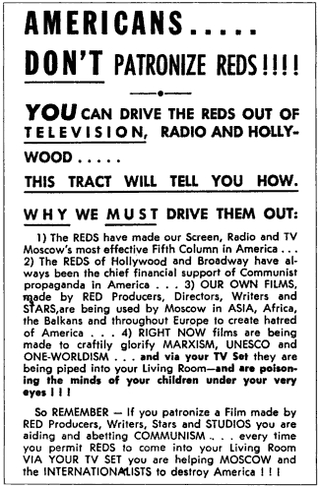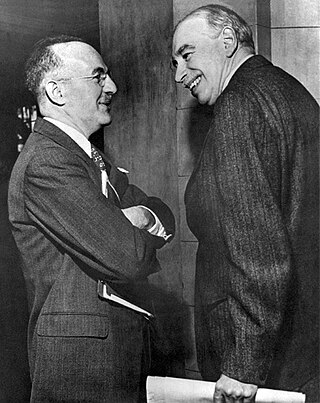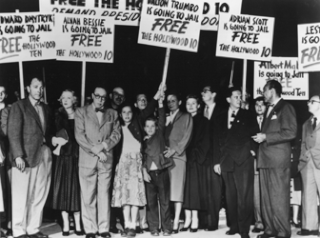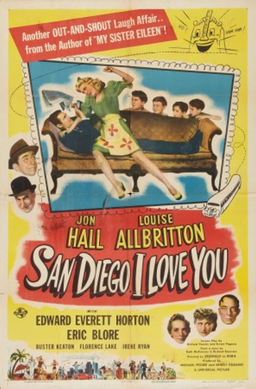Related Research Articles

McCarthyism, also known as the Second Red Scare, was the political repression and persecution of left-wing individuals and a campaign spreading fear of communist and Soviet influence on American institutions and of Soviet espionage in the United States during the late 1940s through the 1950s. After the mid-1950s, U.S. Senator Joseph McCarthy, who had spearheaded the campaign, gradually lost his public popularity and credibility after several of his accusations were found to be false. The U.S. Supreme Court under Chief Justice Earl Warren made a series of rulings on civil and political rights that overturned several key laws and legislative directives, and helped bring an end to the Second Red Scare. Historians have suggested since the 1980s that as McCarthy's involvement was less central than that of others, a different and more accurate term should be used instead that more accurately conveys the breadth of the phenomenon, and that the term McCarthyism is, in the modern day, outdated. Ellen Schrecker has suggested that Hooverism, after FBI Head J. Edgar Hoover, is more appropriate.

Christina Stead was an Australian novelist and short-story writer acclaimed for her satirical wit and penetrating psychological characterisations. Christina Stead was a committed Marxist, although she was never a member of the Communist Party. She spent much of her life outside Australia, although she returned before her death.

Cedric Henning Belfrage was an English film critic, journalist, writer and political activist. He is best remembered as a co-founder of the radical US weekly National Guardian. Later Belfrage was referenced as a Soviet agent in the US intelligence Venona project, although it appears he had been working for British Security Co-ordination as a double agent.

Harry Dexter White was a senior U.S. Treasury department official. Working closely with the Secretary of the Treasury Henry Morgenthau Jr., he helped set American financial policy toward the Allies of World War II. He was later accused of espionage by passing information to the Soviet Union, an allegation which was confirmed after his death.

Nathan Gregory Silvermaster, an economist with the United States War Production Board (WPB) during World War II, was the head of a large ring of Communist spies in the U.S. government. It is from him that the FBI Silvermaster File, documenting the Bureau's investigation into Communist penetration of the Federal government during the 1930s and 1940s, takes its name. His wife, Helen and stepson, Anatole Volkov, were members of his ring.

Elizabeth Terrill Bentley was an American NKVD spymaster, who was recruited from within the Communist Party USA (CPUSA). She served the Soviet Union as the primary handler of multiple highly placed moles within both the United States Federal Government and the Office of Strategic Services from 1938 to 1945. She defected by contacting the Federal Bureau of Investigation (FBI) and debriefing about her espionage activities.
Maurice Hyman Halperin (1906–1995) was an American writer, professor, diplomat, and accused Soviet spy.

Louis Adamic was a Slovene-American author and translator, mostly known for writing about and advocating for ethnic diversity of the United States.
Helen P. Silvermaster was an accused Soviet spy.
Michael Greenberg was a scholar of Chinese economics and history. He was alleged in the first wave of McCarthyism to have provided a Soviet spy with information during the 1940s, but was never charged with espionage.

Iskhak Abdulovich Akhmerov (1901–1976) was a highly decorated OGPU/NKVD (KGB) Soviet security officer, best known to historians for his role in KGB operations in the United States 1942–1945. His name appears in the Venona decryptions over fifty times, often as signatory, and on his return to the Soviet Union in 1945/46, he rose to deputy chief of the KGB's 'illegal' intelligence section.
Harry Magdoff was accused by a number of authors as having been complicit in Soviet espionage activity during his time in US government. He was accused of passing information to Soviet intelligence networks in the United States, primarily through what the FBI called the "Perlo Group." Magdoff was never indicted, but after the end of the Cold War, a number of scholars have inspected declassified documents from U.S. and Soviet archives. They cite these documents to support the claim that Magdoff was involved in espionage. Other authors have taken issue with some of the broader interpretations of such materials which implicate many Americans in espionage for the Soviet Union, and the allegation that Harry Magdoff was an information source for the Soviets is disputed by several academics and historians asserting that Magdoff probably had no malicious intentions and committed no crimes.
Alexander Koral was an American member of the Communist Party of the United States (CPUSA) who headed a network of spies for Soviet intelligence during World War II called the "Art" or "Berg" group. Koral's wife, Helen Koral, also was involved with the group.
Ruth Marguerite McKenney was an American author and journalist, best remembered for My Sister Eileen, a memoir of her experiences growing up in Ohio and moving to Greenwich Village with her sister Eileen McKenney.
The Silvermaster File of the United States' Federal Bureau of Investigation is a 162-volume compendium totalling 26,000 pages of documents relating to the FBI's investigation of GRU and NKVD moles inside the U.S. federal government both before and during the Cold War.
Frederick Vanderbilt Field was an American leftist political activist, political writer and a great-great-grandson of railroad tycoon Cornelius "Commodore" Vanderbilt, disinherited by his wealthy relatives for his radical political views. Field became a specialist on Asia and was a prime staff member and supporter of the Institute of Pacific Relations. He also supported Henry Wallace's Progressive Party and so many openly Communist organizations that he was accused of being a member of the Communist Party. He was a top target of the American government during the peak of 1950s McCarthyism. Field denied ever having been a party member but admitted in his memoirs, "I suppose I was what the Party called a 'member at large.'"

The Hollywood blacklist was the mid-20th century banning of suspected Communists from working in the United States entertainment industry. The blacklist began at the onset of the Cold War and Red Scare, and affected entertainment production in Hollywood, New York, and elsewhere. Actors, screenwriters, directors, musicians, and other professionals were barred from employment based on their present or past membership in, alleged membership in, or perceived sympathy with the Communist Party USA (CPUSA), or on the basis of their refusal to assist Congressional or FBI investigations into the Party's activities.

I'm Dying Laughing: The Humourist is a novel by Christina Stead (1902–1983). It was published posthumously by Virago Press in 1986, edited and with a preface by Ron Geering.

San Diego, I Love You is a 1944 American comedy film directed by Reginald Le Borg and starring Jon Hall, Louise Allbritton and Edward Everett Horton.

Louise BranstenBerman was a member of the Communist Party and a suspected Soviet spy.
References
- 1 2 "Rich. Bransten Dies in London". The San Mateo Times. November 19, 1955. p. 1. Retrieved July 3, 2023.
- ↑ Herken, Gregg (2003). Brotherhood of the bomb: the tangled lives and loyalties of Robert Oppenheimer, Ernest Lawrence, and Edward Teller (1st ed.). New York: Holt. pp. 90–93. ISBN 978-0-8050-6589-3.
- ↑ Meade, Marion (2010). Lonelyhearts: The Screwball World of Nathanael West and Eileen McKenney. Houghton Mifflin. p. 351. ISBN 9780547488677.
- ↑ Whiting, Cécile (1989). Antifascism in American Art. New Haven: Yale University Press. p. 223. ISBN 9780300042597.
- ↑ “Richard Bransten." FBI file for Richard Bransten, page 3, document no. 100-HQ-80068, April 6, 1951.
- ↑ Cherny, Robert W. (2017). Victor Arnautoff and the Politics of Art. University of Illinois Press. p. 139. ISBN 9780252099243.
- ↑ Interlocking Subversion in Government Departments: Hearing Before the Subcommittee to Investigate the Administration of the Internal Security Act and Other Internal Security Laws of the Committee on the Judiciary, United States Senate, Eighty-third Congress, Second Session. Washington D.C.: U.S. Government Printing Office. 1953. p. 2413.
- ↑ Stead, Christina (2005). Dearest Munx: The Letters of Christina Stead and William J. Blake. Miegunyah Press. p. 545. ISBN 9780522851731.
- ↑ "Two Writers Ousted by Communist Party". The New York Times. September 13, 1946. p. 4. Retrieved July 3, 2023.
- ↑ Pender, Anne (May 2004). "'Scorched earth': Washington and the missing manuscript of Christina Stead's I'm Dying Laughing". Australian Literary Studies. 21 (3).
- ↑ Law, Michael John (2019). Not Like Home: American Visitors to Britain in the 1950s. McGill-Queen's University Press. ISBN 9780773559561.
- ↑ Wald, Alan M. (2012). American Night: The Literary Left in the Era of the Cold War. University of North Carolina Press. p. 305. ISBN 9780807835869.
- ↑ Doherty, Caitlin (May 5, 2021). "The Comedy of American Communism". New Left Review.